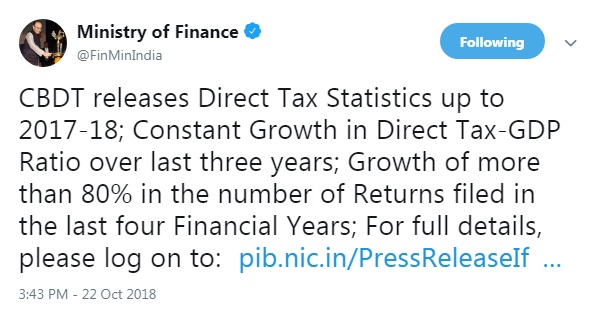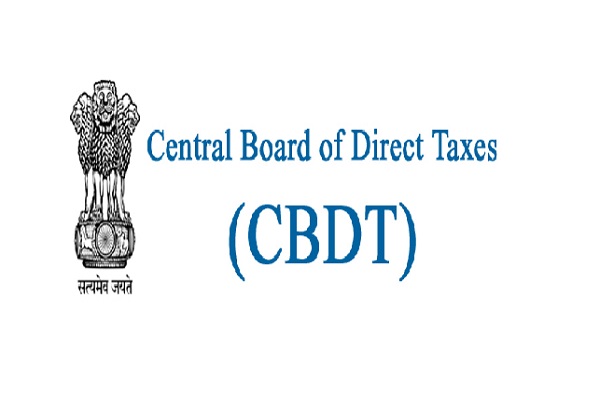Continuing the practice of placing key statistics relating to direct tax collections and administration in public domain, the Central Board of Direct Taxes (CBDT) has further released time-series data as updated up to FY 2017-18 and income-distribution data for AY 2016-17 and AY 2017-18. The key highlights of these statistics are as under:
i. There is a constant growth in direct tax-GDP ratio over last three years and the ratio of 5.98% in FY 2017-18 is the best DT-GDP ratio in last 10 years.
ii. There is a growth of more than 80% in the number of returns filed in the last four financial years from 3.79 crore in FY 2013-14 (base year) to 6.85 crore in FY 2017-18.
iii. The number of persons filing return of income has also increased by about 65% during this period from 3.31 crore in FY 2013-14 to 5.44 crore in FY 2017-18.

(Also read: Extension of due date for availing ITC and FORM GSTR-3B for September, 2018)
There has been continuous increase in the amount of income declared in the returns filed by all categories of taxpayers over the last three Assessment Years (AYs). For AY 2014-15, corresponding to FY 2013-14 (base year), the return filers had declared gross total income of Rs.26.92 lakh crore, which has increased by 67% to Rs.44.88 lakh crore for AY 2017-18, showing higher level of compliance resulting from various legislative and administrative measures taken by the Government, including effective enforcement measures against tax evasion.
(Also read: No Cost EMI is not interest free, know how No Cost EMI works)
The total number of taxpayers (including corporates, firms, HUFs, etc.) showing income of above Rs. 1 crore has also registered sharp increase over the three-year horizon. While 88,649 taxpayers disclosed income above Rs. 1 crore in AY 2014-15, the figure was 1,40,139 for AY 2017-18 (growth of about 60%). Similarly, the number of individual taxpayers disclosing income above Rs. 1 crore increased during the period under reference from 48,416 to 81,344, which translates into a growth of 68%.
(Also read: Online Safety Tips for Parents, Youngsters and Organisation)
The average tax paid by corporate taxpayers has increased from Rs.32.28 lakh in AY 2014-15 to Rs.49.95 lakh in AY 2017-18 (growth of 55%). There is also an increase of 26% in the average tax paid by individual taxpayers from Rs.46,377/- in AY 2014-15 to Rs.58,576/- in AY 2017-18.
(Also read: Revised CBSE Affiliation Bye Laws releases by HRD Minister to ensure speed, transparency, hassle-free procedures)
During the three-year period under reference, the number of salaried taxpayers has increased from 1.70 crore for AY 2014-15 to 2.33 crore for AY 2017-18 (up by 37%). The average income declared by the salaried taxpayers has gone up by 19% from Rs.5.76 lakh to Rs.6.84 lakh.
(Also read: UIDAI introduces "Masked Aadhaar" feature to eAadhaar)
During the same period, there has also been a growth of 19% in the number of non-salaried individual taxpayers from 1.95 crore to 2.33 crore and the average non-salary income declared has increased by 27% from Rs. 4.11 lakh in AY 2014-15 to Rs. 5.23 lakh in AY 2017-18.
(Also read: Not a single mobile phone faces disconnect threat, says DoT)
The availability of the time-series data and the income-distribution data of fairly long periods in the public domain will be found to be useful by the academicians, scholars, researchers, economists and the public at large in studying long-term trends of various indices of the effectiveness and efficiency of direct tax administration in India.
The new releases are available alongwith older publications at www.incometaxindia.gov.in
(Also read: Home Ministry launches portal for reporting Online Sexual Abuse and Cyber Crimes)
(Also read: What is Sexual Harassment and its Punishment)
(Also read: CSIR develops affordable Water Disinfection System known as Oneer)
(Also read: NITI Aayog launches guidelines for PPP in treatment for Non-Communicable Diseases)
For more updates:
1. Like our Facebook Page
2. Join our Telegram Group
3. Join our Facebook Group
4. Subscribe to our Youtube Channel
5. Follow us on Twitter
6. Follow us on Instagram
Disclaimer: The above post includes some content used from PIB India website and executed on this website for fair use only. As this website is of educational nature, hence the content is used for education and awareness to the public.

